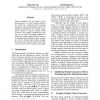Free Online Productivity Tools
i2Speak
i2Symbol
i2OCR
iTex2Img
iWeb2Print
iWeb2Shot
i2Type
iPdf2Split
iPdf2Merge
i2Bopomofo
i2Arabic
i2Style
i2Image
i2PDF
iLatex2Rtf
Sci2ools
76
Voted
ACL
2008
2008
Using Structural Information for Identifying Similar Chinese Characters
Chinese characters that are similar in their pronunciations or in their internal structures are useful for computer-assisted language learning and for psycholinguistic studies. Although it is possible for us to employ imagebased methods to identify visually similar characters, the resulting computational costs can be very high. We propose methods for identifying visually similar Chinese characters by adopting and extending the basic concepts of a proven Chinese input method--Cangjie. We present the methods, illustrate how they work, and discuss their weakness in this paper.
ACL 2008 | Chinese Characters | Computational Linguistics | Similar Characters | Similar Chinese Characters |
Related Content
| Added | 29 Oct 2010 |
| Updated | 29 Oct 2010 |
| Type | Conference |
| Year | 2008 |
| Where | ACL |
| Authors | Chao-Lin Liu, Jen-Hsiang Lin |
Comments (0)

